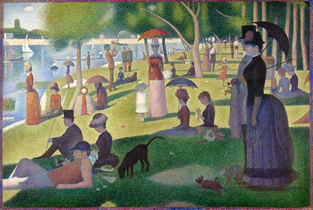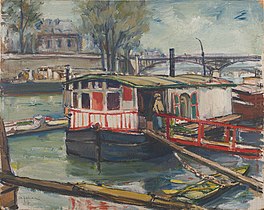
Seine
The Seine (/seɪn, sɛn/ sayn, sen,[1] French: [sɛn] ⓘ) is a 777-kilometre-long (483 mi) river in northern France.[2] Its drainage basin is in the Paris Basin (a geological relative lowland) covering most of northern France. It rises at Source-Seine, 30 kilometres (19 mi) northwest of Dijon in northeastern France in the Langres plateau, flowing through Paris and into the English Channel at Le Havre (and Honfleur on the left bank).[3] It is navigable by ocean-going vessels as far as Rouen, 120 kilometres (75 mi) from the sea. Over 60 percent of its length, as far as Burgundy, is negotiable by large barges and most tour boats, and nearly its whole length is available for recreational boating; excursion boats offer sightseeing tours of the river banks in the capital city, Paris.[4]
"Seine River" redirects here. For other uses, see Seine (disambiguation) and Seine River (disambiguation).Seine
There are 37 bridges in Paris across the Seine (the most famous of which are the Pont Alexandre III and the Pont Neuf) and dozens more outside the city. A notable bridge, which is also the last along the course of the river, is the Pont de Normandie, the ninth longest cable-stayed bridge in the world, which links Le Havre and Honfleur.
The Seine can artificially be divided into five parts:
Below Rouen, the river passes through the Parc Naturel Régional des Boucles de la Seine Normande, a French regional nature park.
[edit]
The Seine is dredged and ocean-going vessels can dock at Rouen, 120 kilometres (75 mi) from the sea. Commercial craft (barges and push-tows) can use the river beginning at Marcilly-sur-Seine, 516 kilometres (321 mi) to its mouth.[5]
At Paris, there are 37 bridges. The river is only 24 metres (79 ft) above sea level 446 kilometres (277 mi) from its mouth, making it slow flowing and thus easily navigable.
The Seine Maritime, 123 kilometres (76 mi) from the English Channel at Le Havre to Rouen, is the only portion of the Seine used by ocean-going craft.[6] The tidal section of the Seine Maritime is followed by a canalized section (Basse Seine) with four large multiple locks until the mouth of the Oise at Conflans-Sainte-Honorine (170 km [110 mi]). Smaller locks at Bougival and at Suresnes lift the vessels to the level of the river in Paris, where the junction with the Canal Saint-Martin is located. The distance from the mouth of the Oise is 72 km (45 mi).[7]
The Haute Seine, from Paris to Montereau-Fault-Yonne, is 98 km (61 mi) long and has 8 locks.[8] At Charenton-le-Pont is the mouth of the Marne. Upstream from Paris seven locks ensure navigation to Saint Mammès, where the Loing mouth is situated. Through an eighth lock the river Yonne is reached at Montereau-Fault-Yonne. From the mouth of the Yonne, larger ships can continue upstream to Nogent-sur-Seine (48 km [30 mi], 7 locks).[9] From there on, the river is navigable only by small craft to Marcilly-sur-Seine (19 km [12 mi], 4 locks).[10] At Marcilly-sur-Seine the 19th century Canal de la Haute-Seine used to allow vessels to continue all the way to Troyes. This canal has been abandoned since 1957.[11]
The average depth of the Seine today at Paris is about 9.5 metres (31 ft). Until locks were installed to raise the level in the 1800s, the river was much shallower within the city, and consisted of a small channel of continuous flow bordered by sandy banks (depicted in many illustrations of the period). Today the depth is tightly controlled and the entire width of the river between the built-up banks on either side is normally filled with water. The average flow of the river is very low, only a few cubic metres per second, but much higher flows are possible during periods of heavy runoff.
Dams and flood control[edit]
Four large storage reservoirs have been built since 1950 on the Seine as well as its tributaries Yonne, Marne, and Aube. These help in maintaining a constant level for the river through the city, but cannot prevent significant increases in river level during periods of extreme runoff. The dams are Lac d’Orient, Lac des Settons, Lake Der-Chantecoq, and Auzon-Temple and Amance, respectively.[12]
Water quality[edit]
Due to concentrated levels of industry, agriculture and urban populations of Paris and its surroundings, the Seine-Normandy watershed experiences the highest human impacts of any hydrographic basin in France. Compared to most other large European rivers, the ability of the Seine to dilute urban sewage and farmland runoff is very low. Low oxygen levels, high concentrations of ammonia, nitrites and faecal bacteria, extending from Paris to the estuary, have been issues for over a century. The advent of nitrogenous fertilizers in the 1960s marked an upturn in agricultural pollution due to land use changes that had previously scaled with population growth. Heavy industries near Paris and along the Oise River discharged virtually untreated wastewaters from the turn of the 19th century, causing concentrations of toxins in the river that were ignored until the late 1980s. Major French laws to address water quality were passed in 1898, 1964, 1996, and 2006.[22]
At the beginning of the 20th century, most domestic sewage was used as fertilizer for nearby croplands. As populations grew, the agricultural capacity to absorb those wastewaters was exceeded. Large-scale construction of waste water treatment plants (WWTPs) began in 1940 to meet demand; however, by 1970, about 60% of urban sewage was allowed to flow into the river untreated. The resulting oxygen depletion reduced the number of fish species to three. Measures taken in the early 2000s due to the Water Framework Directive led to significant reductions of organic carbon, phosphorus and ammonium, which in turn decreased the occurrence and severity of phytoplankton blooms. Continued WWTP construction and new treatment methods improved environmental conditions.[23] In 2009, it was announced that Atlantic salmon had returned to the Seine.[24] By the early 2020s, the number of fish species near Paris had rebounded to 32.[23]
Periodically the sewage systems of Paris experience a failure known as sanitary sewer overflow, often in periods of high rainfall. Under these conditions, untreated residential and industrial sewage is discharged into the Seine to prevent backflow. This is due in large part to Paris' "single system" drainage scheme dating from the 19th century, which combines street runoff and sewage.[25][26] The resulting oxygen deficit is principally caused by allochthonous bacteria larger than one micrometre in size. The specific activity of these sewage bacteria is typically three to four times greater than that of the autochthonous (background) bacterial population. Heavy metal concentrations in the Seine are relatively high.[27] The pH level of the Seine at Pont Neuf has been measured to be 8.46. Despite this, the water quality has improved significantly over what several historians at various times in the past called an "open sewer".[28]
In 2018, a €1.4 billion ($1.55 billion) cleanup programme called the "Swimming Plan" was launched with the aim of making the river safe to use for the 2024 Summer Olympics. The project includes constructing a basin to store rainwater, which would then be slowly released into the sewer system, preventing overflow. Plans also call for several public swimming areas to be made available by 2025, ending a 102-year ban instituted in 1923 due to the polluted water.[29] Efforts have been successful, with the fish population surging from just 2 species to over 30.[30] However, E. coli levels are still far higher than what is safe to swim in, though this could depend on the season.[31][30]
1900 Summer Olympics[edit]
At the 1900 Summer Olympics, the river hosted the rowing, swimming, and water polo events.[36] Twenty-four years later, it hosted the rowing events again at Bassin d'Argenteuil, along the Seine north of Paris.[37]
Operation Overlord[edit]
The Seine was one of the original objectives of Operation Overlord in 1944. The Allies' intention was to reach the Seine by 90 days after D-Day. That objective was met. An anticipated assault crossing of the river never materialized as German resistance in France crumbled by early September 1944. However, the First Canadian Army did encounter resistance immediately west of the Seine and fighting occurred in the Forêt de la Londe as Allied troops attempted to cut off the escape across the river of parts of the German 7th Army in the closing phases of the Battle of Normandy.
Some of the Algerian victims of the Paris massacre of 1961 drowned in the Seine after being thrown by French policemen from the Pont Saint-Michel and other locations in Paris.
Dredging[edit]
Dredging in the 1960s mostly eliminated tidal bores on the lower river, known in French as "le mascaret."
World Heritage Sites[edit]
In 1991 UNESCO added the banks of the Seine in Paris—the Rive Gauche and Rive Droite—to its list of World Heritage Sites in Europe.[38]
In 2007 55 bodies were retrieved from its waters; in February 2008, the body of supermodel-turned-activist Katoucha Niane was found there.[39]
2024 Summer Olympics[edit]
In 2024, the River is set to be host to a boat parade with boats for each national delegation during the opening ceremony of the 2024 Summer Olympics.[40]
During the 19th and the 20th centuries in particular the Seine inspired many artists, including:
A song 'La Seine' by Flavien Monod and Guy Lafarge was written in 1948.
Josephine Baker recorded a song 'La Seine'[41]
A song 'La seine' by Vanessa Paradis feat. Matthieu Chedid was originally written as a soundtrack for the movie 'A Monster in Paris'



